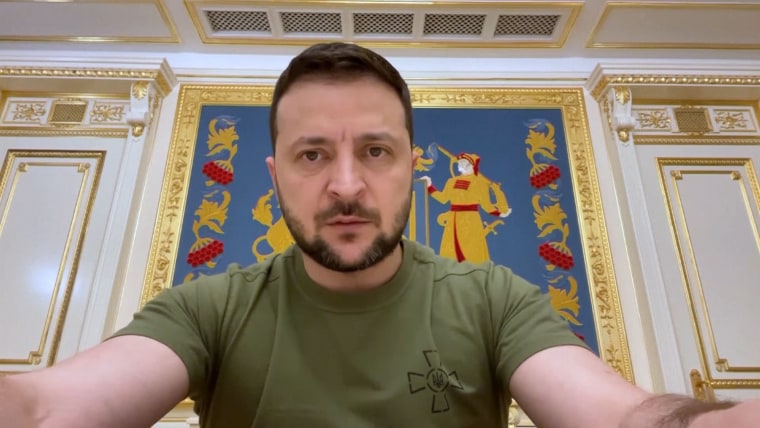Russian propaganda efforts aided by pro-Kremlin content creators, research finds
A small network of pro-Kremlin content creators have seen their audiences grow dramatically in recent months while spreading disinformation about the war in Ukraine, evading social media platforms’ efforts to curb Russian propaganda and paving a path to Western audiences, according to research published Wednesday.
The creators are self-described “independent journalists” whose reports are often made from Russian-occupied areas of Ukraine and amplify Kremlin talking points and downplay or deny reported Russian atrocities. Researchers say the on-the-ground reports — which come in English, French, German and other languages — have proved effective at circumnavigating commitments from European governments and U.S.-based social media platforms to stop the spread of Russian propaganda.
Soon after Russia invaded Ukraine in February, many tech platforms took steps to curb the amplification of false Russian narratives.
Facebook, Instagram and YouTube blocked Russian state-controlled media in Europe and throttled recommendations of those accounts. Facebook and YouTube have banned Russian state-controlled media outlets from advertising. Twitter, Facebook and YouTube apply labels and links to fact checks on content that violates their policies against disinformation about the war.
Most of these efforts focused on official Russian government and state media accounts. That plan, while partially effective, misses a major vector of Kremlin disinformation, according to the Institute for Strategic Dialogue, a London-based think tank that produced the research.
“The current strategy is too focused on explicit affiliation with the Kremlin, state media accounts and outlets, journalists with explicit affiliations, and embassies and consulates,” said Melanie Smith, ISD’s director of digital analysis. “It misses a large volume of content coming from actors who can reach huge audiences very quickly and spread pro-Kremlin disinformation without the state actually having to be directly involved.”
Content creators and social media influencers have emerged in the past year as one of the newer avenues for disinformation. Some YouTubers exposed a plot to use creators to spread Covid disinformation, while The Associated Press reported in March that China’s government had found success with its own network of English-language creators.
The war against Ukraine has been a boon to once small-time, Kremlin-friendly content creators, some of whom have been active for years. The researchers identified a group of 12 of the most influential of these creators, who post to social sites including YouTube, Telegram, Facebook and Twitter.
Those creators have seen their audiences grow since Russia invaded Ukraine, most notably on YouTube and Telegram. Some of the creators profit from crowdfunding, ads attached to their YouTube videos despite policies barring monetization, and chat functions that allow users to donate during livestreams.
Telegram and YouTube did not respond to requests for comment.
Among the dozen most influential Western propagandists identified by ISD is Alina Lipp, a German creator who claims backing Ukraine is akin to supporting Nazism and reported the debunked claim that Ukrainians perpetrated a false flag massacre at a maternity hospital in Mariupol. Lipp’s following (mostly on Telegram, but also YouTube) grew from about 2,000 in February to over 160,000 in May. Lipp did not respond to a request for comment.
ISD also named Eva Bartlett, a Canadian activist who previously pushed conspiracy theories alleging Syrian rescue workers known as the White Helmets were staging fake attacks during the Syrian civil war. Bartlett isn’t employed by RT, the Russian state-controlled news network, but she has written op-eds on RT’s website, makes videos with RT correspondents and shares archived versions of RT content to get around the platforms’ blocking of Russian state media. Facebook has labeled Bartlett’s posts with a disclaimer that she “may be partially or wholly under the editorial control of the Russian government.” Bartlett did not respond to a request for comment.
Gonzalo Lira, a Chilean American who previously posted misogynistic content, now makes pro-Russian videos from inside Ukraine, including denying Russian involvement in what Ukrainian officials say was the killing of more than 400 people in the city of Bucha.
Human rights organization Amnesty International reported that Russian troops engaged in torture and “extrajudicial killings” there. Lira’s YouTube following has tripled since the invasion to 153,000. Lira did not respond to a request for comment.
The most popular of the pro-Kremlin influencers identified by researchers is Patrick Lancaster, a Missouri-born Navy intelligence veteran and self-described independent crowdfunded journalist embedded with the Russian army. Since December, Lancaster’s YouTube channel has grown from 57,500 subscribers to more than 500,000, with daily dispatches from Russian-occupied Ukraine. His videos are often breathless reports with graphic footage of dead bodies, violence for which Lancaster claims Ukraine is responsible. The scene in at least one video was reportedly staged. Lancaster often appears on Russian state media and on the Texas-based conspiracy theory radio show “Infowars.”
Below Lancaster’s YouTube videos, he posts, “I show what the western media will not show you.” He did not respond to a request for comment.
Human rights organizations have documented numerous cases of apparent war crimes perpetrated by the Russian military against Ukrainian civilians. The United Nations estimated that more than 9,300 Ukrainian civilians have been killed in the war, but said the actual count is “considerably higher.”
Smith said the creators have proven particularly difficult to moderate and a powerful tool for spreading propaganda.
“Some of the disinformation that we see spread quickly isn’t being fact-checked because they’re reaching an audience that is deemed to be smaller or less important than that reached by RT and Sputnik, but the talking points are the same and the evidence being presented is the same,” Smith said. “These are independent people who can speak freely within the bounds of the policies of the platforms. And sometimes, that spills over into incitement of violence, denying war crimes and spreading very blatant pieces of disinformation about the context of what’s happening and about how people are being victimized.”



